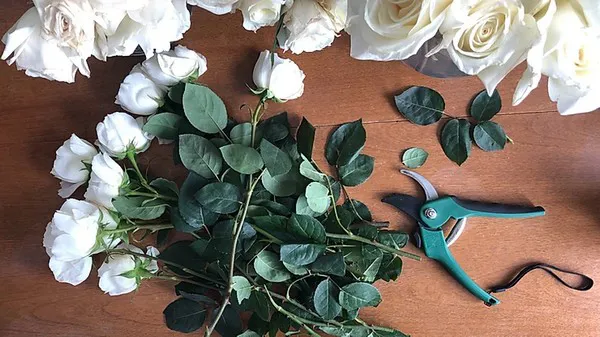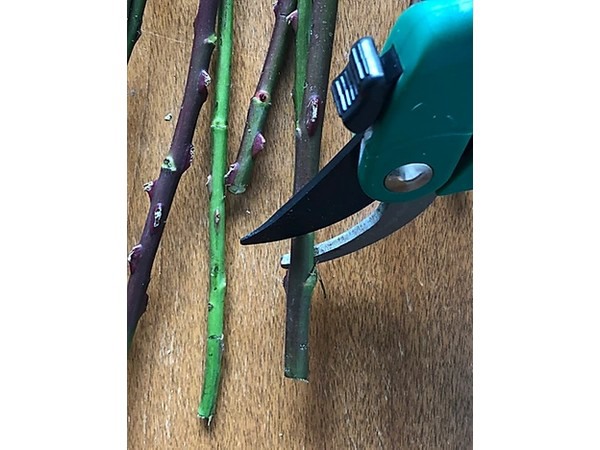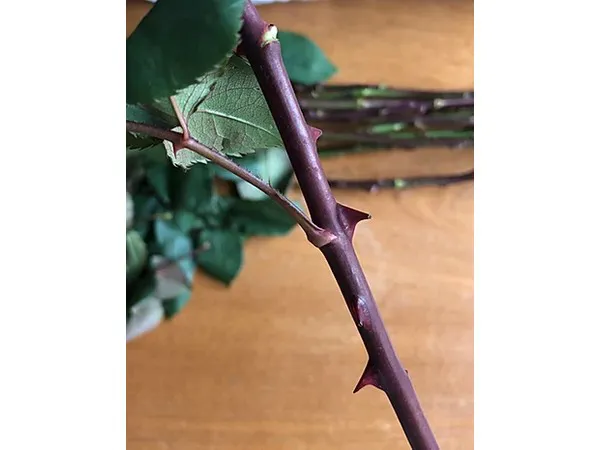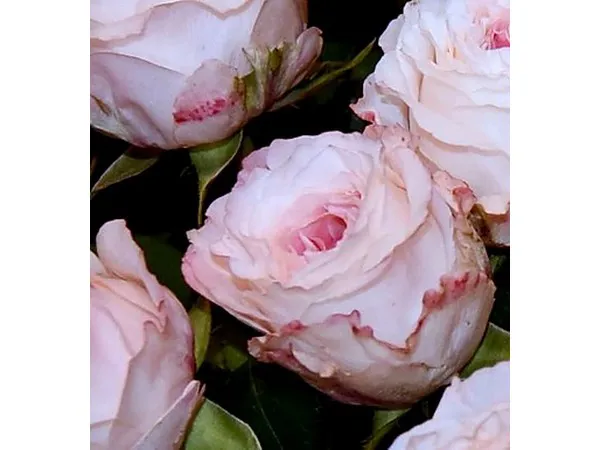When working with garden roses to create a wedding bouquet or any other design, one of the first questions to ask is, “How much do I really want to take away?”
In general, garden roses will be at their most beautiful when you take away as little as possible. And while removing some parts of the flower may well be necessary, there’s a right and a wrong way to do it.

Prep time is well spent when you are protecting your quality investment in premium garden roses, says J Schwanke of UBloom.com, one of the world’s best-known flower experts. In the past, florists working exclusively with hybrid tea roses often began by stripping away the leaves and thorns, then plucking off the outer petals as a matter of course. Today, the thinking has evolved—and the popularity of garden roses, with their opulent, natural look, is one reason why.
The first cut: Trimming the stem
Preparing roses involves one essential step of removal: always cut an inch or more from the bottom of the stem with a clean, sharp knife or bypass cutter, to facilitate renewed uptake of water and nutrients. With garden roses, this is advisable even if you are using a no-cut flower-food solution.

Leaves to be desired and de-thorning techniques
Rose leaves function as the lungs of a plant. On their underside are pores, called stomata, that facilitate gas exchange. They literally allow the rose stem to breathe. And that “breathing” encourages the flow of water and nutrients up the stem, allowing the cut flower to open and color up.
Leaves that fall below the waterline in a vase or processing bucket tend to favor the growth of bacteria in the water. These leaves should always be removed with a clean, sharp knife. And yes, often you will need to remove all the leaves on a rose stem to accommodate your design. But whenever possible, it’s helpful to the vase life of the rose to leave any foliage intact that won’t be submerged or crushed.
Garden roses from Alexandra Farms, like other roses on the market, do have thorns—but the quantity and quality of the thorns vary quite a bit. Some varieties have more, some less; some have shorter, softer thorns while others are quite sharp and hard.

One technique for dealing with thorns is to break them off by hand, simply pushing them aside one by one. This is time-consuming, and it may cause some tissue damage. A preferable technique is to trim each thorn with a clipper, dulling the point.
Thorns actually help the rose to take up water. And while no one wants to get stuck by a thorn, when thorns and leaves are roughly stripped from the stem, that process runs the risk of tearing at the skin of the rose stem and creating an open wound.
Consider this: any cutting that is done to a rose, including the peeling of guard petals and de-thorning, leaves wounded tissue exposed to floating bacteria and the spores of botrytis mold. “Above the water line, that wound becomes a place where air and bacteria can enter the stem,” says J. Air and bacteria can block the flow of water and nutrients, shortening the rose’s life.
Therefore, when roses are held in buckets or arranged in vases, it’s ideal to remove only those thorns and leaves that fall below the water line. The real key is to do whatever paring and pruning need to be done with minimal damage to the rose.
But if you have especially thorny stems, you may need to resort to grasping the stem with a tool like a stem stripper (J recommends the kind made of flexible plastic and shaped like a flower) or a heavy-duty terrycloth towel. Either of these will remove leaves as well as removing or dulling thorns. Always pull from the top of the stem toward the bottom: conveniently, the thorns themselves point downward. That’s another reason to remove them below the waterline, says J, since they can otherwise tear at leaves as you insert them into a vase or bucket.

Garden roses are famous for their subtle color variations, their high petal count, and the way they open up all the way and hold in that position—like a ballerina on point. The outermost petals play a role in all of that, adding to the fullness of the bloom and the depth of its delicate palette.
These outer petals also have a protective function—that’s why they’re called “guard petals.” With any roses, if the guard petals are truly damaged or appear to be already in a state of decay, they should be carefully removed. But if they are simply a different color, perhaps slightly tougher in texture, consider leaving them in place. In the fully open rose, often the outer petals are pushed down so that from above, only the edges are visible.
Get the 'fresh from the garden' look
A natural look—as though fresh cut from the garden, with perfect health and minimal processing—just feels right for garden-rose varieties. That means, when it comes to how much you take away from a garden rose, less is more. The same motto applies to the professional care that you expend in grooming each flower and stem for optimum beauty and performance.
For more tips on getting the most from our garden roses, visit the Care & Handling page.

 Alexandra Farms
Alexandra Farms